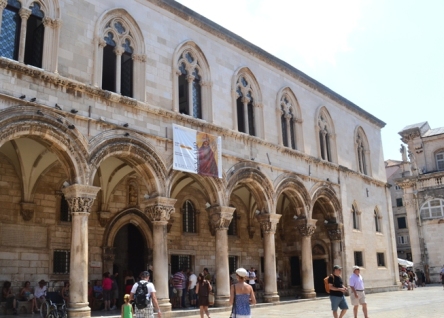

Open: 9am- 6pm May- Oct
9am- 4pm Nov- Apr
Entrance Fee: 35 KN, audio guide 30 KN

Rector's Palace was erected in the 15th century. It was erected a rector or a prince that ruled over Dubrovnik Republic that existed for around 1000 years. Bust statue of Miho Prasatu is visible in the atrium of this beautiful Renaissance building. He was a sailor who lived in the 17th century. He managed to gain considerable wealth through his life time. Upon his death Miho Prasatu donated his whole fortune to independent Dubrovnik Republic. In 1638 city erected a small statue in the official residence of Dubrovnik ruler. It is the first and the last time when a commoner got such a distinction. Today it is converted into a town museum devoted to its history. Amazingly this beautiful building survived fires, several earthquakes, explosions of gunpowder in the basement and other accidents.
The Dubrovnik Museum, or the Palace of the Rector
(in Croatian: Knežev dvor) is a palace in the city of Dubrovnik that
served as the seat of the Rector of the Republic of Ragusa between
the 14th and 18th centuries. It was also the headquarters of the
Minor Council and the state administration. In addition, it housed
an armory, a surveillance house and a prison. It is currently a
mausoleum with furnished rooms, baroque paintings and historical
exhibits. It is next to the city council. The city has another
museum called Zitnica Rupe. The rector's palace was built in Gothic
style, but also features Renaissance and Baroque elements, which
harmoniously combine these elements.
Originally, at the
beginning of the Middle Ages, the site was a defense building. It
was destroyed by a fire in 1435 and the city decided to build a new
palace. The work was offered to the construction maker Onofrio della
Cava of Naples, who had previously built the city's aqueduct and a
fountain that bears his name. Palace of the Rector became a gothic
building with ornaments sculpted by Pietro di Martino in Milan. An
explosion of gunpowder stored damaged the building in 1463. The
renovation was offered to the architect Michelozzo of Florence, but
was rejected in 1464 because his plans were too much in the style of
the Renaissance.
Other builders continued the work. The
capitals of the porch were renovated in Renaissance style, probably
by Salvi di Michele of Florence. The reconstruction was continued as
of 1467. The building suffered damages from the earthquake of 1520
and again in 1667. The reconstruction was done in the Baroque style.
A flight of stairs and a bell to the atrium were added. The
Department of History of the Museum of Dubrovnik has operated in the
Palace of the Rector since 1872.